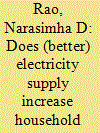|
|
|
Sort Order |
|
|
|
Items / Page
|
|
|
|
|
|
|
| Srl | Item |
| 1 |
ID:
115651


|
|
|
|
|
| Publication |
2012.
|
| Summary/Abstract |
This paper helps to address the lack of comprehensive, national-scale information on the reliability of the U.S. electric power system by assessing trends in U.S. electricity reliability based on the information reported by the electric utilities on power interruptions experienced by their customers. The research analyzes up to 10 years of electricity reliability information collected from 155 U.S. electric utilities, which together account for roughly 50% of total U.S. electricity sales. We find that reported annual average duration and annual average frequency of power interruptions have been increasing over time at a rate of approximately 2% annually. We find that, independent of this trend, installation or upgrade of an automated outage management system is correlated with an increase in the reported annual average duration of power interruptions. We also find that reliance on IEEE Standard 1366-2003 is correlated with higher reported reliability compared to reported reliability not using the IEEE standard. However, we caution that we cannot attribute reliance on the IEEE standard as having caused or led to higher reported reliability because we could not separate the effect of reliance on the IEEE standard from other utility-specific factors that may be correlated with reliance on the IEEE standard.
|
|
|
|
|
|
|
|
|
|
|
|
|
|
|
|
| 2 |
ID:
121388


|
|
|
|
|
| Publication |
2013.
|
| Summary/Abstract |
Electricity access is an important driver of economic development. Previous studies treat electrification as a binary outcome. In reality, in developing countries households with access face chronic supply interruptions, which can last up to 12 h a day. This is the first study to estimate the income differences in urban and rural non-farm enterprises in Indian households with different levels of electricity supply, using a subset of 8125 households in the India Human and Development Survey, a cross-sectional national sample of 41,554 households. I use multiple econometric approaches, including linear regression with an instrument variable and propensity-score matching with multiple treatment levels to represent supply availability. I find a robust income effect of access, and suggestive evidence of the effect of better supply availability. The aggregate income impact across existing NFEs in India of improving supply to 16 h a day could be on the order of 0.1 percent of GDP.
|
|
|
|
|
|
|
|
|
|
|
|
|
|
|
|
| 3 |
ID:
177436


|
|
|
|
|
| Summary/Abstract |
Transitioning the electric power sector to rely more on wind and solar photovoltaics (WPV) has long been cited as a potential solution to reducing harmful greenhouse gas emissions associated with fossil fuel electricity production. An under-explored implication of this transition, however, is whether increasing the amount of net generation supplied by WPV negatively impacts power system reliability? In this paper, we empirically investigate the preceding question using an unbalanced panel dataset of utility-scale operations between 2013 and 2017. Disruptions in power system reliability are measured by the frequency and duration of power system disruptions experienced by end-consumers. Results suggest net generation from WPV, on average, has a significant positive impact on the length of power system disruptions experienced, but only at low levels of net generation from WPV. As net generation from WPV increases, the duration of power system disruptions decreases. To provide insight into the policy implications of these results, we forecast disruptions in power system reliability, assuming different renewable energy policy scenarios for states across the United States with active renewable support policies in place. We estimate the economic costs of forecasted disruptions using an open-source, interruption cost estimate calculator.
|
|
|
|
|
|
|
|
|
|
|
|
|
|
|
|
| 4 |
ID:
092748


|
|
|
|
|
| Publication |
2009.
|
| Summary/Abstract |
Using data from the North American Electric Reliability Council (NERC) for 1984-2006, we find several trends. We find that the frequency of large blackouts in the United States has not decreased over time, that there is a statistically significant increase in blackout frequency during peak hours of the day and during late summer and mid-winter months (although non-storm-related risk is nearly constant through the year) and that there is strong statistical support for the previously observed power-law statistical relationship between blackout size and frequency. We do not find that blackout sizes and blackout durations are significantly correlated. These trends hold even after controlling for increasing demand and population and after eliminating small events, for which the data may be skewed by spotty reporting. Trends in blackout occurrences, such as those observed in the North American data, have important implications for those who make investment and policy decisions in the electricity industry. We provide a number of examples that illustrate how these trends can inform benefit-cost analysis calculations. Also, following procedures used in natural disaster planning we use the observed statistical trends to calculate the size of the 100-year blackout, which for North America is 186,000 MW.
|
|
|
|
|
|
|
|
|
|
|
|
|
|
|
|
| 5 |
ID:
132612


|
|
|
|
|
| Publication |
2014.
|
| Summary/Abstract |
Hong Kong has almost perfect electricity reliability, the result of substantial investments ultimately financed by electricity consumers who may be willing to accept lower reliability in exchange for lower bills. But consumers with high outage costs are likely to reject the reliability reduction. Our ordered-logit regression analysis of the responses by 1876 households to a telephone survey conducted in June 2013 indicates that Hong Kong residents exhibit a statistically-significant preference for their existing service reliability and rate. Moreover, the average residential cost estimate for a 1-h outage is US$45 (HK$350), topping the estimates reported in 10 of the 11 studies published in the last 10 years. The policy implication is that absent additional compelling evidence, Hong Kong should not reduce its service reliability.
|
|
|
|
|
|
|
|
|
|
|
|
|
|
|
|
|
|
|
|
|